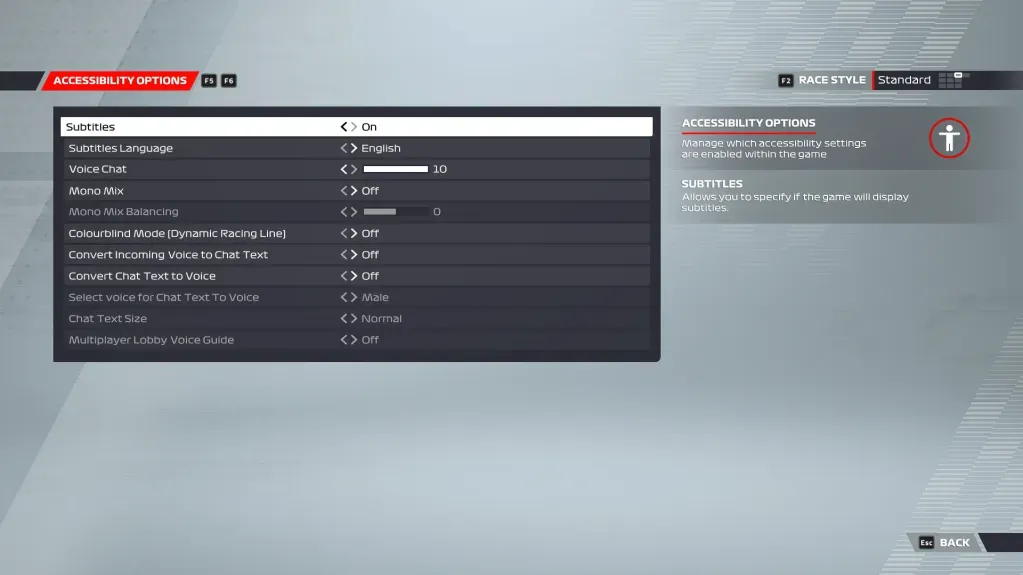Steam accessibility tags are set to revolutionize the way disabled gamers discover and engage with video games. By allowing developers to highlight how their creations support varied accessibility features, Steam aims to foster a more inclusive gaming environment. These new tags offer crucial insights into gameplay options like adjustable difficulty, color alternatives, high contrast displays, and text-to-speech functionalities. As game developers utilize Steamworks accessibility tools, they can guide players in finding titles that best cater to their needs and preferences. This initiative not only enhances gaming for disabled individuals but also serves as a model for promoting inclusive gaming across the industry.
The introduction of accessibility indicators on Steam represents a significant step toward creating a more inclusive gaming landscape. These markers help identify titles that offer essential features aimed at players with disabilities, streamlining their gaming experience. With tools that include customizable volume settings, narrated menus, and gameplay adjustments, developers can reshape how their audiences interact with games. Enhanced accessibility options cater to a broader demographic, showcasing a commitment to diverse gaming experiences. This initiative also empowers developers by providing them with the means to make informed decisions that prioritize accessibility in their game designs.
Understanding Steam’s Accessibility Tags for Inclusive Gaming
Steam has made great strides in fostering inclusive gaming through the introduction of accessibility tags. These tags serve as a bridge for disabled players seeking games that cater to their specific needs. By allowing developers to indicate how their titles support various accessibility features, Steam enhances the overall gaming experience, making it more approachable for everyone. This initiative emphasizes the importance of inclusive gaming, ensuring that no one is left out due to barriers that traditional game design may impose.
The accessibility tags on Steam are indeed a game changer. They not only empower disabled players by making it easier to find suitable games but also encourage game developers to prioritize accessibility in their projects. This newfound focus on accessibility features is a significant development in the gaming landscape, where inclusivity is becoming increasingly essential. By leveraging the Steamworks platform, developers can clearly outline gameplay options for a diverse audience, paving the way for a more inclusive gaming community.
Key Accessibility Features that Enhance Gaming Experiences
Accessibility features have become a focal point for game developers looking to create engaging and inclusive experiences. Options like adjustable difficulty levels allow players with varying skills to enjoy games without feeling overwhelmed. Furthermore, text size adjustments and color alternatives ensure that visually impaired players can participate fully in the gaming world. High contrast settings and speech-to-text functionalities are vital for those with hearing and sight challenges, transforming the way they interact with games.
Incorporating these accessibility features into game design is not just good practice; it is a responsibility that developers should embrace. With the newly integrated questionnaire in Steamworks, developers can now specify how their games accommodate these various needs. This shift highlights the commitment to accessibility in gaming and serves as a template for future titles. The industry is evolving, and with these enhancements, gaming is becoming a more inclusive environment for everyone.
The Role of Game Developers in Promoting Accessibility
Game developers play a crucial role in championing accessibility in gaming. By actively participating in initiatives like the Steamworks accessibility features questionnaire, they can meaningfully contribute to a more inclusive gaming culture. As these developers embrace accessibility options, they are not only expanding their audience but also encouraging a sense of community that values each player, regardless of their abilities. This attitude fosters a gaming environment that rewards creativity and innovation in making games accessible to all.
Moreover, developers who prioritize accessibility are paving the way for future innovations. As they integrate various accessibility features, including custom volume controls and narrated menus, they set a standard for the industry. This focus can inspire smaller indie developers to adopt similar practices, expanding the inclusive gaming landscape further. The collective effort to promote access in gaming ensures a vibrant and diverse community where everyone can find joy in playing.
Accessibility Initiatives: Aligning with Steamworks
Steamworks has taken a proactive approach towards enhancing game accessibility through its latest initiatives. The incorporation of a specific questionnaire for developers is a testament to their commitment to inclusive gaming. This not only allows developers to highlight the accessibility features in their games but also creates a benchmark for other platforms to follow. As the gaming industry evolves, such initiatives are essential in shifting the narrative towards inclusivity, ensuring that gaming is accessible to all.
By aligning their efforts with Steamworks’ accessibility mandate, developers can better engage with the disabled community. This engagement fosters a greater understanding of the needs of diverse players, leading to more thoughtful game design. As Valve continues to promote these initiatives, the ripple effects will likely influence other entities within the gaming ecosystem to adopt similar accessibility frameworks.
Game Discoverability Through Accessibility Tags
One of the most significant benefits of integrating accessibility tags on Steam is the improved discoverability of games for disabled players. By implementing specific filters for these tags, players can easily navigate the vast library of games available on the platform. This tailored approach means that disabled gamers no longer have to rely solely on random searches or trial and error. Instead, they can directly find games that cater to their personal accessibility needs, enhancing their overall experience.
The introduction of discoverability through accessibility tags marks a significant shift in the gaming industry, encouraging all developers to think inclusively. Now, with a clear path for marketing games through these tags, developers can reach a broader audience while also making their commitment to accessibility apparent. This dual benefit not only improves player engagement but also elevates the status of developers who prioritize inclusivity.
Educational Resources for Developers on Accessibility
As the conversation surrounding accessibility in gaming grows, so does the need for game developers to educate themselves on best practices. Various resources and workshops are now available that focus on implementing accessibility features effectively in game design. These educational tools can help developers understand the specific needs of disabled players, guiding them in creating more inclusive experiences. By taking advantage of these resources, developers can transform their approach to game design, ensuring that accessibility is a core component from the outset.
Moreover, collaborations with organizations that specialize in gaming for disabled individuals provide invaluable insights. By engaging with experts, developers can learn directly from the community about the challenges faced by disabled gamers. This knowledge equips developers to innovate and refine their games, making accessibility features not just an afterthought but a fundamental part of the game development process.
Innovations in Gameplay Accessibility Features
Innovations in gameplay accessibility features are revolutionizing the way games are designed. Developers are now exploring new technologies that enhance gameplay for disabled players. For instance, voice control and motion sensing technology allow gamers with limited mobility to play without traditional controllers. Such advancements are paving the way for a more diverse range of games, designed with inclusivity at their heart.
By integrating cutting-edge accessibility features like these, developers can create unique gaming experiences that cater to a wider audience. As the gaming landscape becomes more inclusive, it will inspire innovative design that considers all players’ needs. This focus on accessibility not only enhances gameplay but also enriches the overall gaming culture, encouraging inclusivity and creativity.
Community Feedback and Its Impact on Inclusive Gaming
Community feedback plays a vital role in shaping accessible gaming experiences. As players engage with games that prioritize accessibility, their insights can significantly influence future developments. Game developers who actively seek and incorporate community feedback demonstrate a commitment to creating inclusive environments, ensuring that players feel valued and heard. This collaborative spirit fosters a sense of ownership within the gaming community, driving positive change towards accessibility.
Additionally, online platforms and forums can be excellent venues for sharing experiences and suggestions. By facilitating open dialogue about accessibility issues, developers can gain a clearer understanding of the specific challenges encountered by disabled players. This valuable feedback loop not only supports game improvement but also builds a foundation for lasting relationships between the developers and the gaming community.
The Future of Gaming: Embracing Inclusivity and Accessibility
Looking forward, the future of gaming lies in embracing inclusivity and accessibility as central themes. With platforms like Steam taking the lead by implementing accessibility tags and features, there is a growing expectation for all developers to follow suit. As the industry evolves, it is imperative that game developers prioritize these values in their design process, ensuring that everyone can participate in the gaming experience.
In addition to enhancing game design, this shift towards inclusivity can also boost the gaming market. A broader audience leads to increased sales and engagement, fueling innovation and creativity within the industry. Ultimately, the commitment to accessibility will shape a future where gaming is not just a pastime, but a versatile medium for connection and enjoyment across diverse communities.
Frequently Asked Questions
What are Steam accessibility tags and how do they support inclusive gaming?
Steam accessibility tags are features introduced by Valve to enhance inclusive gaming by allowing game developers to label their games with specific accessibility options. This helps disabled players easily identify games that cater to their needs, thereby improving their gaming experience and promoting a more inclusive gaming environment.
How can game developers utilize Steamworks accessibility features?
Game developers can utilize Steamworks accessibility features by completing a new questionnaire provided in the Steamworks interface. This questionnaire prompts developers to specify various accessibility options their games offer, such as adjustable difficulty, color alternatives, and text-to-speech functionalities, ensuring that they effectively communicate their inclusive gaming features to potential players.
What types of accessibility options can be tagged on Steam games?
Steam games can be tagged with various accessibility options including gameplay adjustments like difficulty settings, visual aids such as high contrast and color alternatives, auditory features like speech-to-text, and customizable volume controls. These tags enable players with disabilities to find games that best suit their specific needs.
Why are accessibility features important in gaming for disabled individuals?
Accessibility features are crucial in gaming for disabled individuals because they provide essential tools that enhance gameplay and enjoyment. By including various options that accommodate different disabilities, game developers can create an inclusive gaming experience that ensures everyone has the opportunity to participate and enjoy games.
How can the new accessibility tags on Steam help improve game discovery for disabled gamers?
The new accessibility tags on Steam significantly improve game discovery for disabled gamers by allowing them to filter games based on their accessibility needs. This systematic labeling makes it easier for players to find titles that support their specific disabilities, ultimately enhancing their gaming opportunities and fostering a more inclusive community.
What role do game developers play in the implementation of Steam accessibility tags?
Game developers play a pivotal role in the implementation of Steam accessibility tags by accurately describing their games’ accessibility features through the Steamworks questionnaire. Their input ensures that the tags reflect true capabilities, helping players make informed choices and find games that suit their accessibility requirements.
How does Valve’s emphasis on accessibility support inclusive gaming culture?
Valve’s emphasis on accessibility through Steam’s new features supports inclusive gaming culture by acknowledging and addressing the needs of disabled gamers. By providing tools for developers to showcase their accessibility options, Valve promotes a more diverse and welcoming gaming environment where all players can engage and enjoy gaming.
Can players contribute to the discussion about accessibility features on Steam?
Yes, players can contribute to the discussion about accessibility features on Steam through reviews and feedback. By sharing their experiences with different games and their accessibility options, players can inform other gamers and developers about important accessibility considerations, fostering a community dialogue that encourages improvement in inclusive gaming.
What impact do Steam accessibility tags have on the gaming industry?
Steam accessibility tags have a significant impact on the gaming industry by pushing game developers to prioritize and integrate accessibility features in their games. This shift not only increases awareness about the importance of accessibility but also encourages the creation of more inclusive gaming experiences, ultimately benefiting a larger audience.
How can players find games with Steam accessibility tags?
Players can find games with Steam accessibility tags by using the search and filter options on the Steam platform, where they can specify their preferred accessibility features. This functionality allows gamers to easily access a variety of titles that meet their specific needs, enhancing their overall gaming experience.
| Key Point | Description |
|---|---|
| Introduction of Accessibility Tags | Steam introduces accessibility tags to help disabled players discover games that cater to their needs. |
| Developer Questionnaire | A new questionnaire for developers is now part of Steamworks to outline accessibility features. |
| Gameplay Options | Developers can indicate options like adjustable difficulty, color contrasts, and text size adjustments. |
| Accessibility Features | Features include speech-to-text, text-to-speech, custom volume controls, and narrated menus. |
| Game Store Integration | The accessibility questionnaire is part of the ‘edit store’ section for each game on Steam. |
Summary
Steam accessibility tags are a significant step towards creating a more inclusive gaming environment. These tags will empower disabled players by making it easier for them to identify games that include features catering to their specific needs. With the addition of a detailed questionnaire for developers, the gaming community can look forward to a greater range of accessibility options, ensuring that gameplay is enjoyable for everyone.



